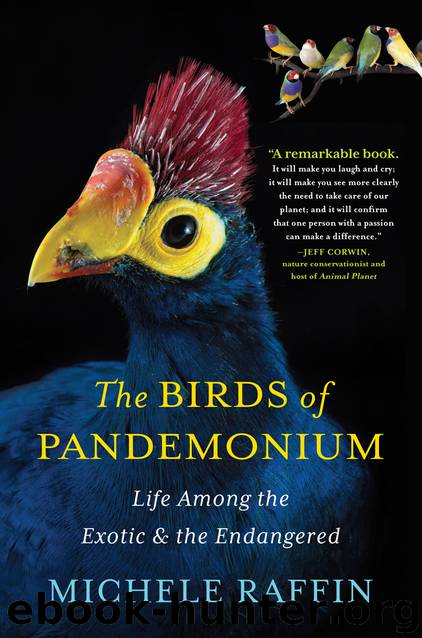The Birds of Pandemonium by Michele Raffin

Author:Michele Raffin
Language: ara, eng
Format: epub, mobi
Publisher: Algonquin Books
Published: 2014-08-13T17:02:15+00:00
NINE
Mail-Order Bride
On those TV reality shows about animal rescue, the abuses are often appallingly clear—emaciated dogs and cats, skeletal horses, all delivered from their suffering by uniformed officers in shiny vans. Bird rescues are quite different.
Imagine a call coming in: “Dispatch, we have a lorikeet being fed birdseed!”
“Copy that, we’ll get an investigator over there ASAP!”
What average person would see cruelty—possibly fatal—looking at a pretty parrot with a dish full of seed? The clues to abuse, neglect, and illness in birds are often not apparent to the untrained eye. As we found with Amigo, a robust, good-looking parrot can actually be in serious danger from obesity. As a rescuer, you really have to know what to look for.
One day I received a call from a local bird rescue group to stand by for a possible adoption. They had received a phone tip about a rainbow lorikeet seen at the Bird Mart, an avian bazaar held every three months or so in our area in a large hall at the fairgrounds. Bird and bird supply vendors come from miles away to sell their goods at prices that are considerably below those at pet stores. The people selling birds are either small backyard breeders or brokers. Most accept cash only—and good luck finding them afterward if you have questions or problems with your purchase. The birds sold are sometimes sick and are sent to their new homes with few or no care instructions.
The rescue informant clearly knew about rainbow lorikeets. They are medium-size parrots, about ten inches high, native to Australia and a few smaller Pacific islands. Their colors are stunning: royal-blue heads with bright red beaks, green bodies, and a ruffled bib of scarlet across their chests. Lorikeets are now protected in Australia, where they have long been marketable as pets. They’re pretty, congenial, and cheerfully antic. They subsist on fruit, pollen, and nectar, and their tongues have a sticky appendage at the end to gather their food from deep within blossoms. They are not meant to eat seed, except as part of the fresh fruits they consume. Giving them a dried seed diet can result in sick, malnourished birds.
The rescue group told me that they were sending a volunteer to the Bird Mart to have a look. If she felt the bird was in serious trouble, she was to buy it and bring it to me. They would put up the purchase funds if I agreed to keep the parrot. At the market, the volunteer found only one vendor selling lorikeets; he had two of them, from different lorikeet subspecies. The rescuer approached the vendor and pointed out that the lorikeets’ food dishes were full of seed and had gone untouched. The vendor brushed her off. “Don’t worry about them. They’ll be fine. They’re just not hungry—too much excitement here.”
She was not reassured. If the vendor didn’t know how to feed these lorikeets, he was unlikely to give the right feeding advice to any buyer, and the birds would die. One of the birds didn’t look too bad, but the other was in awful shape.
Download
This site does not store any files on its server. We only index and link to content provided by other sites. Please contact the content providers to delete copyright contents if any and email us, we'll remove relevant links or contents immediately.
The Lonely City by Olivia Laing(4751)
Animal Frequency by Melissa Alvarez(4395)
All Creatures Great and Small by James Herriot(4233)
Walking by Henry David Thoreau(3895)
Exit West by Mohsin Hamid(3778)
Origin Story: A Big History of Everything by David Christian(3650)
COSMOS by Carl Sagan(3558)
How to Read Water: Clues and Patterns from Puddles to the Sea (Natural Navigation) by Tristan Gooley(3409)
Hedgerow by John Wright(3277)
The Inner Life of Animals by Peter Wohlleben(3261)
How to Read Nature by Tristan Gooley(3250)
How to Do Nothing by Jenny Odell(3235)
Project Animal Farm: An Accidental Journey into the Secret World of Farming and the Truth About Our Food by Sonia Faruqi(3178)
Origin Story by David Christian(3148)
Water by Ian Miller(3129)
A Forest Journey by John Perlin(3027)
The Plant Messiah by Carlos Magdalena(2883)
A Wilder Time by William E. Glassley(2818)
Forests: A Very Short Introduction by Jaboury Ghazoul(2790)
